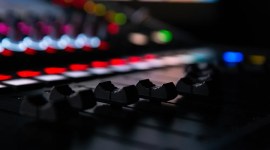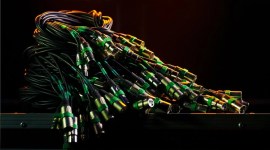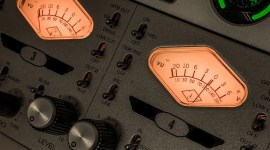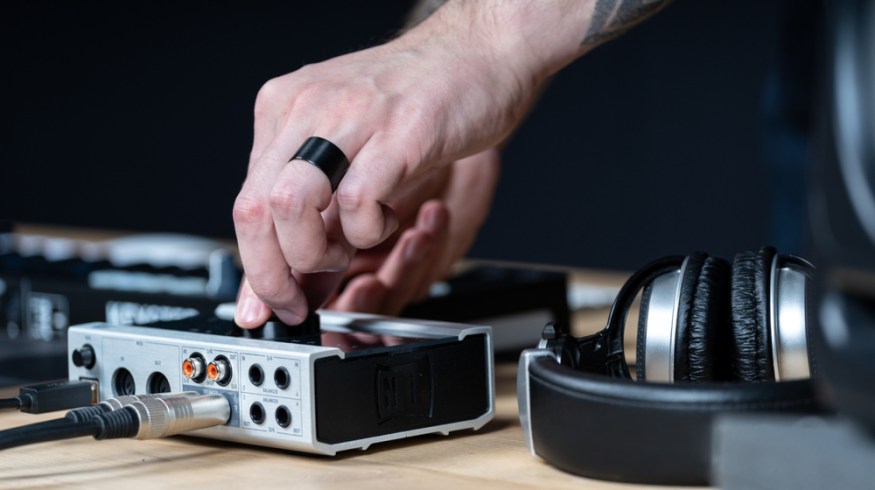
The 7 Best Audio Interfaces of 2022 + Bonus Video
When choosing an audio interface, you can choose by what’s new or price point, but the best way is to refine why you want such an interface.
How do you choose an audio interface? You can define your choice by what’s new, which is what we’re doing here. You can restrict your selection on price or brand, but the best way is to figure out why you want such an interface.
For instance, If you’re moving into multi-instrument recording, then the choice is more apparent as you’ll need several more inputs and some onboard DSP to lessen the load on your computer.
Or, if you’re running a podcast or streaming, you need to justify your spending and understand if your chosen interface allows some loopback function to use your system audio. However, you may only need a couple of inputs and are just looking for the best microphone performance. All those avenues are here.
Whatever you need, take our information as part of your research. We’ll try to highlight what makes these new interfaces worth your consideration. Running a whole load of specs doesn’t translate on a medium like this, but we will “spec up” when we feel the need.
1. Apogee Duet 3 – $649
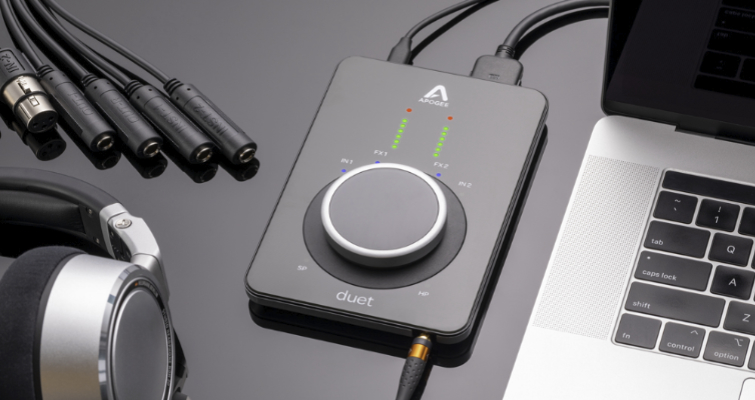
In 2007, Apogee made its first personal and portable audio interface, Duet. It reflected when music recording had largely exited big recording rooms and gone home to feed the productions made inside computers—they didn’t need natural room acoustics.
The Duet 3 is an apparent evolution of the original unit with its beautiful Gorilla glass-slated minimal design—it almost feels like a piece of audiophile gear. The look is part of the allure, but Apogee has the technical chops to back it up—they’ve been in the conversion game for over thirty years, which counts for something.
Check out the specs.
Duet 3 has onboard hardware DSP, allowing for low latency with the optional virtual channel strip Symphony ECS plugin. Apogee has brought along engineer, mixer, and producer Bob Clearmountain to “tune” the strip. But, more importantly, to relieve him of some of his presets. So, plug in and instantly start sounding like Toto, The Rolling Stones, Bon Jovi, and Bruce Springsteen (among other superstars).
Other than the ECS strip, Duet 3 will gain you entry into their plugin world, now available on rent–to–own or project–to–project basis.
Duet 3 is $649 (the ECS channel strip is only $49.50 when bought simultaneously). To smarten up the break-out cable, there’s also now a Duet Dock Duet. It’s an extra $149 but will tidy up that ugly bunch of break-out cables users seems to hate.
Duet 3 has sex appeal but perhaps is limited by its IO. However, if the basic 2×4 arrangement is all you need, then with Duet 3, you have the cool factor. The real strength lies in Apogee plugin FX, and there’s a fourteen-day free trial.
2. Focusrite Clarett+ 2Pre – $400
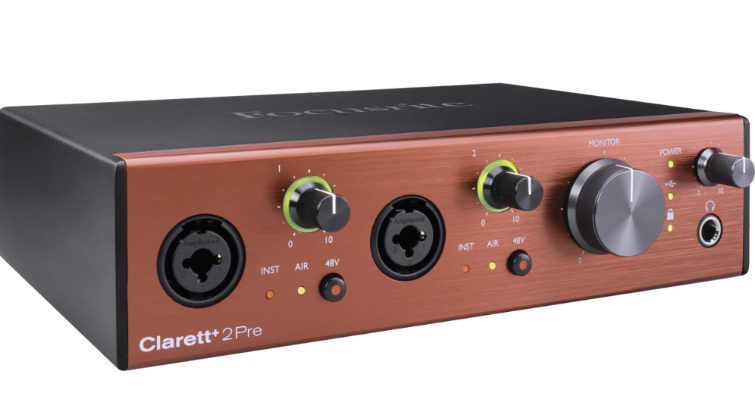
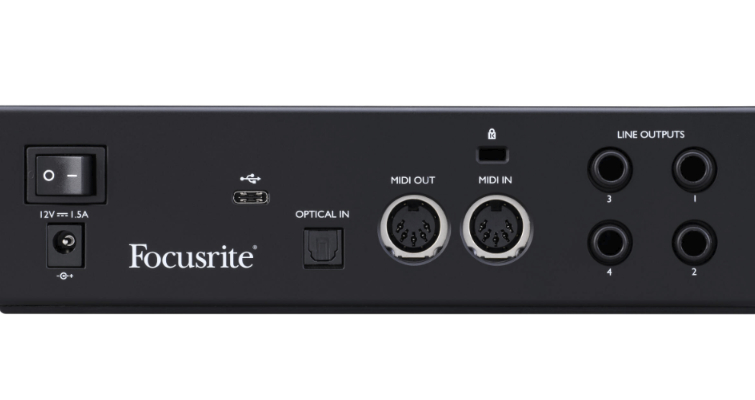
Since Focusrite was in its professional audio console prime in the last century, color has played a large part in its industrial designs. Their Red range of 1U channel strips gained mythical status based on those consoles, and the theme has continued with the Scarlett and Clarett interfaces of the last few years. Now we have Clarett+, with improvements over Clarett.
Clarett+ has upgraded 24-bit/192 kHz AD/DA conversion, and their two microphone preamps are Air-enabled, a circuit that can model the sound of the company’s classic ISA preamps. Focusrite describes AIR as: “Making vocals shine, brings added presence to guitars, and makes drum overheads shimmer.” This is an analog process, so there is no DSP or latency; therefore, no timing issues. AIR on the Clarett is also improved from the Scarlett interfaces.
Dedicated, high-impedance JFET instrument inputs are also new, with a comprehensive audio bandwidth. The idea is to mimic guitar amp inputs to preserve the natural tone of guitars and capture their true character.
Clarett+ 2Pre is the smallest of the new range, with the 4Pre and 8Pre above it. But it’s the 2Pre that’s going to interest most people. Apart from the better conversion and AIR settings, these new units have MIDI in and out, so you can use drum machines, synths, and controllers—something Duet 3 hasn’t got. There’s also a TOSLINK optical input, which can accept an 8-channel ADAT input, increasing your mix choices.
The Clarett+ 2Pre also includes a software package featuring Focusrite Red plugins and a channel strip that accurately models that rare Focusrite Studio Console.
For users of the Scarlett range of interfaces, the Clarett+ is worth a look. Given Focusrite’s legendary status in the sound industry, there will be plenty of buyers for old Scarlett boxes.
3. Antelope Zen Go Synergy Core – $499.00
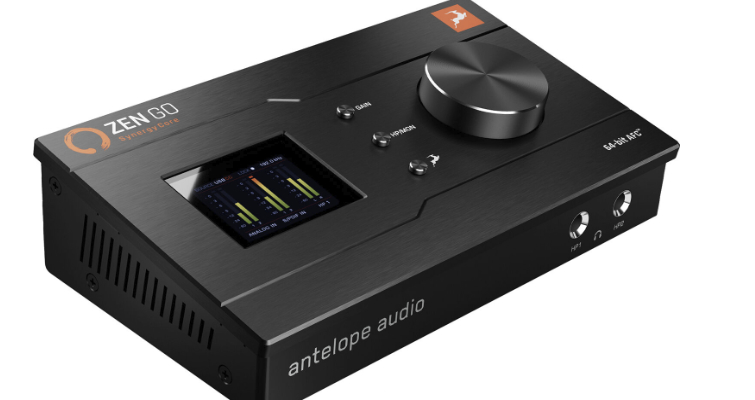
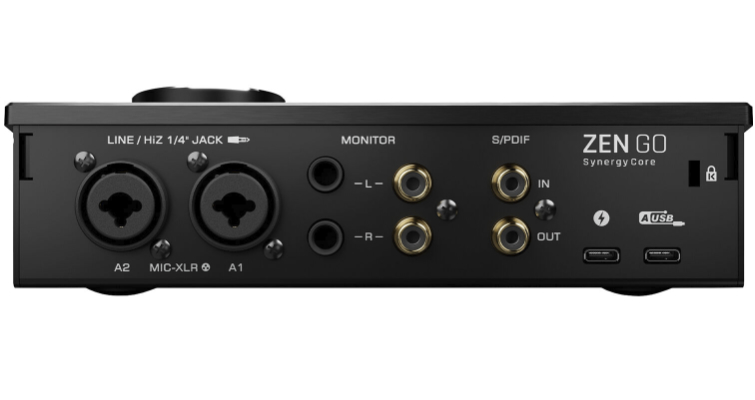
Antelope’s new audio interface looks like a small wedge-shaped mixing console. Still, with minimal controls on the top, a large encoding wheel is surrounded by smaller select buttons, and there are design cues from Apogee’s Duet range.
Again, we have a USB-C connection with a four-in and eight-out configuration. Still, Zen Go is the first to push their digital jitter management and master clock as part of their AFC badge—the 64-bit Acoustically Focused Clocking technology.
But let’s not get bogged down with this kind of marketing. The ultimate test is to drive your microphones, line levels, and instruments with what’s on offer; the spec takes you so far.
You can add positive elements like USB bus power, S/PDIF I/O, and two stereo headphone outputs with separate gain control to send a different mix to a second headphone.
Like Focusrite and Apogee, there’s a virtual FX part of the interface called Synergy Core FX. Currently, there are thirty-seven choices of FX, from auto-tune to emulations of classic tube processing. Try before you buy these bundles is the best way to enter this rich world of creative sound.
Antelope also promise a near delay-free experience and that you can stack up your processing chain without fear of overloading it, which is a nice feature (please try this as soon as possible if you buy a unit).
The Zen Go also has a loopback feature (you’ll hear this feature mentioned frequently as you read this article). This lets you use your System Audio for apps like Zoom—teams even your browser, and record those sessions to your DAW.
This new unit ticks many boxes but has audio purity as its number one priority. Worth consideration for sure.
4. Black Lion Audio Revolution 2×2 – $399

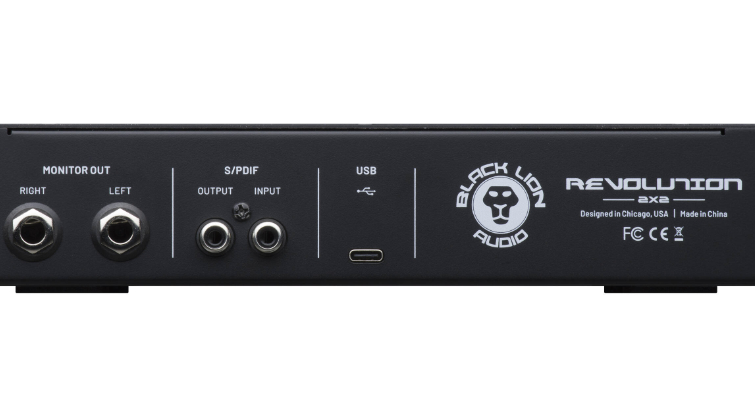
The Revolution 2×2 is the company’s first audio interface, previously known as a modifier of other people’s audio gear. It looks like they’ve thrown their DAC kitchen sink at it with some pretty strong claims, like:
All of the analog I/O has not only been built with the finest components, but are fully decoupled and balanced—right to the very core of the converter! Most manufacturers do not follow this practice, and that allows extra noise contamination during both capture and playback.
– Black Lion Audio
Ironically, there’s been some criticism of their noise floor performance, but this kind of electronic modification is nice to see and usually experienced in higher-priced products.
Black Lion’s marketing even mentions the ICs they use—Vishay, Nichicon, and Wima capacitors are used throughout the entire circuit.
As its name suggests, the 2×2 has that number of IOs but with digital S/PDIF IO on the rear panel. Although, you can’t mix a digital and analog input. The rest of the parameters are like all the other interfaces here—AD DA conversion is up to 24 bits at 192 kHz. You connect through USB-C and have high-performing mics, line levels, and instrument preamps. Again, the proof is in the listening, but Black Lion’s claims are mighty.
They’ve been modding audio gear for a while, so they know what works and doesn’t. The unit has also had good reviews, so you should make your shortlist if you don’t mind recording two inputs at a time. This might be the interface for a voice professional who won’t care about the meager IO count.
There’s also a similar entry to virtual FX through a bundle of software, including the PreSonus Studio One Artist DAW and plugins from Brainworx, iZotope, and Lindell Audio.
5. Audient iD4 MKII Desktop 2×2 – $199
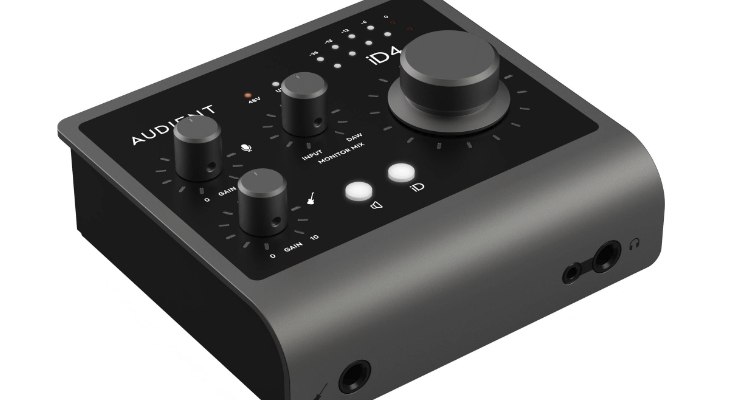
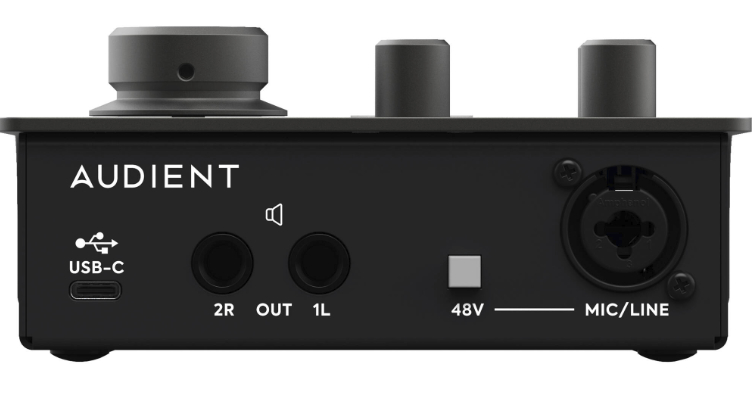
The iD4 MKII is another desktop device derived from the glory days of analog music consoles from the last century. As in any technical digital migration, people still yearn for that warmth of sound or vision if you’re talking celluloid.
As with others in this list, iD4 MKII is connected via USB-C but has a single preamp for mic/line from their console range. There’s a separate DI input for your instrument, with a high-impedance JFET circuit to give it that valve-type sound. (Learn more about JFET circuits here from the Focusrite knowledge base). You also get bus power through USB, so there is no need for a power brick.
AD DA conversion is rated at 24 bits, but the sampling frequency is halved against most interfaces in the list at 96kHz, not the average doubling at 192Khz. But the converters have been improved for this upgraded unit, so let your ears be your guide.
Some nice touches are in this second version of the iD4, including a double headphone jack at the front—3.5mm and 1/4″—which allows you to send a signal to someone else. But the volume control is ganged for both outputs, so there is no independent control.
The bundled software you get with the unit shows some more unique touches. For instance, when you’re using the Steinberg Cubase LE and Cubasis LE 3, which works on Mac/Windows and iOS, you can turn your encoder knob into a virtual version for use in the DAW, and there are some monitor parameters you can use, too.
Connecting up the iD4 2 to iPhones (or, more likely, iPads) is a matter of dongle hell with the camera dongle, and a USB power extender needed—but it’s doable. You could get a new iPad Pro if you’re going to be mobile.
Lastly, and perhaps one of the reasons this upgrade exists, is Audient’s new loopback feature, which will interest Podcasters and content creators who want to import system audio apps like Zoom or even browser content.
6. MOTU Ultralite MK5 18×22 – $595
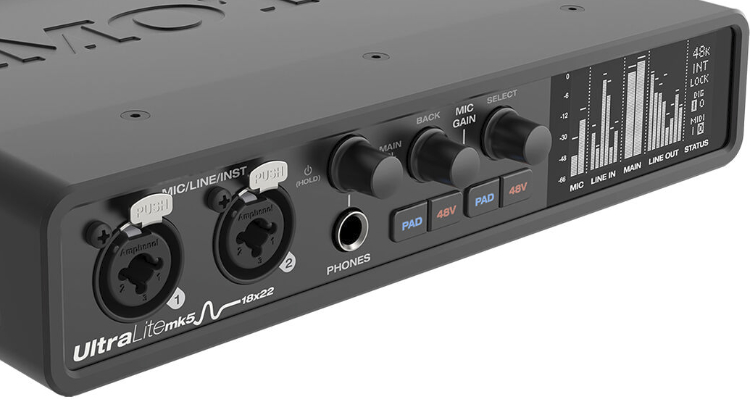
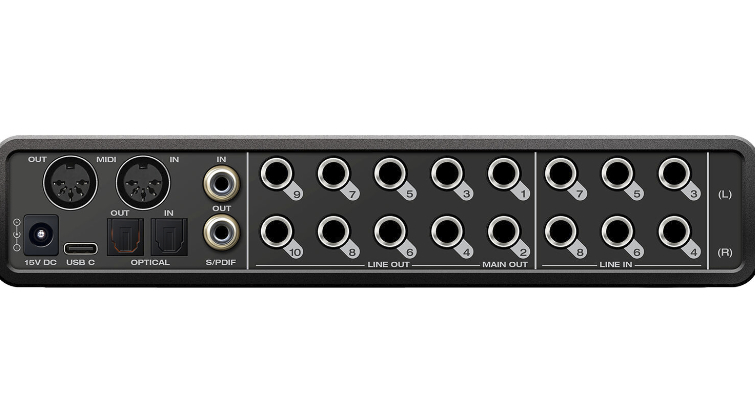
Comparing the 5th version of MOTU’s UltraLite and Apogee’s Duet 3 shows the breadth of this market. The new UltraLite is all business with its multiple IOs and plain but sturdy, metal casing. The Duet 3 is excellent and minimalist, but with supreme underlying ability. Duet is slightly more expensive, too.
So, what’s MOTU offering this time? The amount of innovation to warrant a 5th iteration of this interface includes new ESS Sabre32 DACs and decoupled outputs. To break that down, ESS makes audiophile DACs and decoupling is all about avoiding inherent noise from closely stabled components. So, MOTU is stepping up its sonic efforts.
AD DA conversion is now on par with the best in this list, with up to 24 bits / 192 kHz. There’s the usual USB-C connectivity but with optical TOSLINK/ADAT I/O and S/PDIF IO. Staying with the rear panel, you have multiple other IOs, enough for a small studio set-up to accommodate various uses.
There are ten balanced TRS outputs, six balanced TRS inputs on the rear, and MIDI in and out. On the front panel, you have your standard combo XLR/TRS inputs with phantom power, but new for this list is a -20dB pad if the signal comes in too hot.
Headphone controls are there, which double up as the main monitor level and also as an off switch for the unit. A new OLED screen finishes everything up, which looks fantastic.
The unit is USB audio class compliant, giving you plug-and-play compatibility with an iPad, but you have to use the bundled CueMix 5 software, which hasn’t the best reputation.
The included software also features virtual instruments and 6GB of free loops and samples. The new Mk5 also has the now-required loopback feature for your content creation.
I’ve only touched on what’s in this interface, so it’s worth doing some added research as it seems quite comprehensive.
7. PreSonus Revelator io24 Desktop 2×4 – $199.95
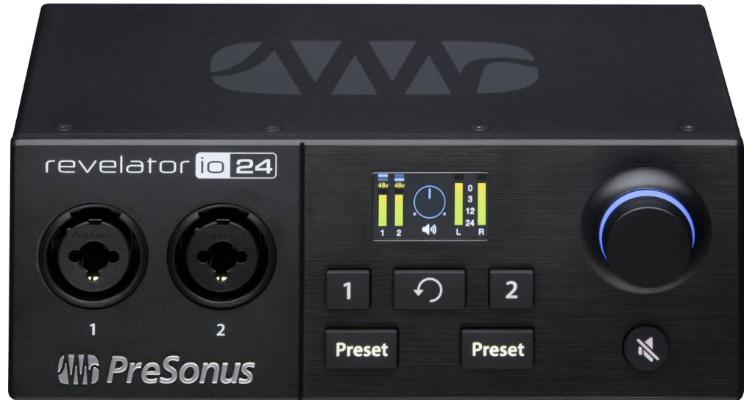
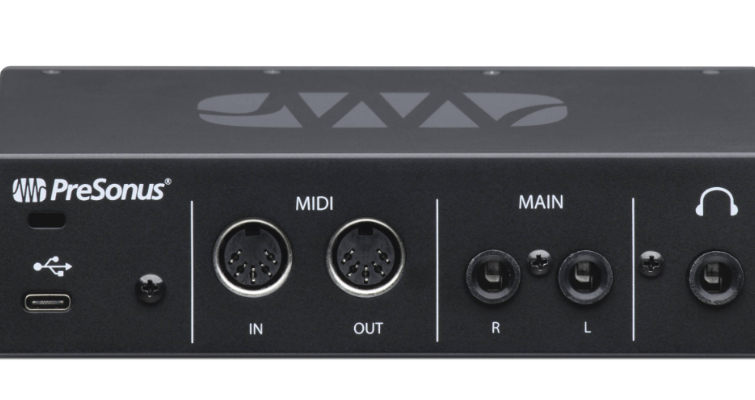
Our final new audio interface of 2021 (so far) is from PreSonus, and we think it was created on the back of their new DSP microphone, the Revelator. Being digital, the mic came with a suite of software that you could adjust for anything from plain singing to gaming, with presets to use on the microphone itself. All PreSonus needed was some hardware to bring in more of the analog world—musicians, for instance.
But, more than that, they wanted to invite the podcaster and streamer to a more high-fidelity world. So, here’s the io 24 interface with high amounts of DSP to hone your show.
This is an interface for everyone—not specific like Duet 3—but I’m not sure you’ll see it in many recording studios. Yes, you have a few mic/instrument preamps, which should be reasonable given Presonus’ twenty-five years of experience. On the front, you also have an encoder wheel, mute button, and input select with presets—there are two per button.
The presets will introduce you to how PreSonus wants you to use the interface—through control software and their own Studio One Artist production and recording software. You also get a bundle of free software called the Studio Magic Plug-In Suite for Mac and Windows includes Ableton Live Lite. PreSonus says there’s $1000 worth of free stuff here.
The control software will give you unique and infinite levels of signal control you can spend hours playing with. You’re also introduced to a loopback mixer and a Stream Mix Mode. Engage in and the complete mix of your analog inputs, loopback channels, reverb, and effects is routed directly to USB to be sent to OBS or similar streaming hosts.
Here’s another audio interface with plenty to get your creator teeth into, but make sure there’s not too much choice for what you need.
Audio Recorder vs. Camera Recording – Bonus Video
If you’ve only recently ventured into the world of filmmaking and sound recording, you may wonder what the difference is between having a dedicated audio recorder, like the ones listed above, and recording straight into your camera.
Well, worry not; our friend Lewis McGregor has a video that covers this exact topic.
Here are a few more audio tips, tricks, and advice for you:
- High-End Audio in Budget-Friendly Field Recorders
- Easy Audio: The New Deity Pocket Wireless Microphone
- Prevent Hard Audio Cuts with Natural Reverb
- Helpful Tips Every Audio Engineer Wants You to Learn
- The 3-Tier Hierarchy for Ranking Audio Recording Gear
Cover image via brizmaker.


